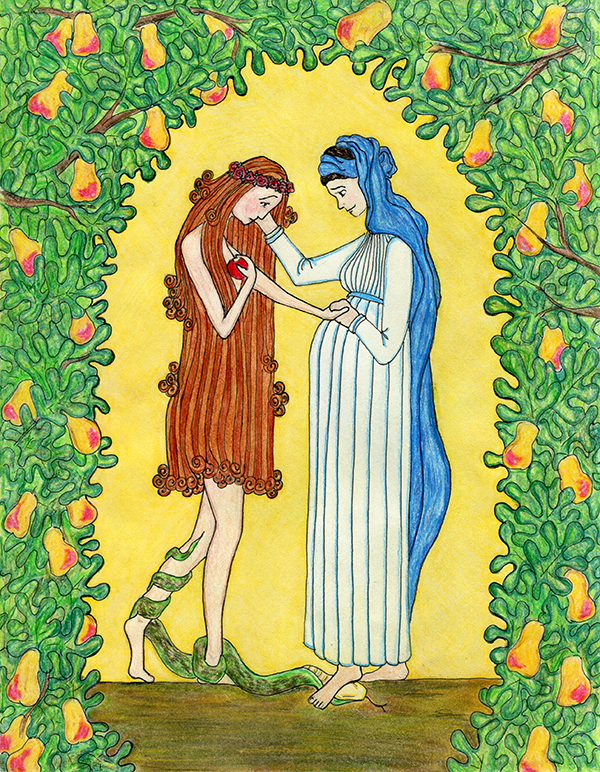Subtotal: $
Checkout
Mary Consoles Eve
Advent seems the perfect time to reflect on Mary and Eve, these two “mothers of all the living.”
By Sr. Grace Remington and Joy Marie Clarkson
December 20, 2022
In this interview, Plough’s Joy Clarkson speaks with Sister Grace Remington, a Cistercian nun at Our Lady of the Mississippi Abbey in Iowa, a convent that supports itself by making Christmas candy. Joy asks Sister Grace about her artwork Mary and Eve, what art she ponders during Advent, and how the sisters at the abbey prepare for Christmas.
Joy Clarkson: Tell us a bit about yourself.
Sr. Grace Remington: I grew up in Cedar Falls, Iowa, a small city about one hundred miles west of the monastery. My parents both taught in the English department at the university there, so I grew up with a great love for the written word. Like my father, I was baptized Catholic, but most of my childhood Christian formation took place in my grandmother’s church (Reformed Church of America) and my mother’s (Presbyterian). As for major influences, I was born in 1971, so two words: Star Wars. There was a cemetery behind my house which served as the neighborhood playground and Star Wars battlefield, and as a result, I grew up with a real sense of community across time with those who have died – the communion of saints. We knew all those graves, and while we didn’t know the people, they still felt like neighbors and friends in a very real sense.
Now I am a Cistercian sister at Our Lady of the Mississippi Abbey in Iowa. We live a simple life here. We are contemplative nuns, so we do not teach or work in parishes. We pray together seven times a day. Each service centers on the chanting of the psalms, the reading of scriptures, and the singing of hymns. We make candy to support ourselves, and I help with that work. I also tend our grounds, take care of the chickens, and am the community librarian. We are out in the country, so when there is a little extra time, I like to go out for long walks. Our days start early, at 3:30 a.m., and end early, with everyone in their rooms by 8:00 p.m. We have a lot of silence in our days, but we also enjoy each other a lot. We hope to live a life of praise and prayer, dedicating ourselves and this place to God, pointing to the One who holds all things together.
How did you come up with the idea for Mary and Eve?
I drew The Ladies, as I call them, over the course of a couple of afternoons. The truth is that there really wasn’t one thing in my mind, but a number of things. I tend to draw as I think, and I was thinking about a talk I was supposed to give to my sisters that focused on the person of Mary. Since most of my upbringing was in the Protestant tradition, I didn’t grow up with the same sense of relationship with Mary most of my sisters did, so I started by thinking about who Mary was to me. As I pondered this, all sorts of other themes like redemption and grace, shame and compassion, the mystery of the Incarnation, and the promises of salvation came to my mind.

Sr. Grace Remington, Mary and Eve, crayon and pencil, 2005. Used by permission.
I never intended to share the picture with anyone outside the monastery, but I liked it well enough, so I showed it to some of my sisters. Sr. Martha asked if she could use it for making the community Christmas card. I was surprised, but told her if she wanted to use it, she was welcome to it. A few people who received our card started posting images of it online. It has been both surprising and touching to see how the image moves people. I don’t feel a lot of personal responsibility for that. I am not a great drawer. Whatever the image is saying to people has little to do with me: The Ladies are just doing their work! I help process orders in the mail-order office for our candy business. We sell prints, and sometimes there will suddenly be a bunch of orders from Australia or somewhere, and I’ll know that the Ladies are up to something.
What do you hope people will learn or receive from your drawing?
I hope the Ladies speak of the graciousness and gratuitousness of God’s mercy, and how God’s message of salvation is communicated through compassion and kindness. One of the things I was pondering as I drew this picture was the question of why Eve said “no” to God and Mary said “yes.” I started to think about how Eve had no idea what it would mean to live in a fallen world, to be separated from God. Whatever purity of soul Mary had, Eve had in her creation too. And yet, whatever innocence Mary had, she was not spared the experience of living in a fallen world. First-century Palestine was no Garden of Eden. I wondered whether Mary was able to give her yes precisely because she knew the pain of life. She knew how desperately we needed God. Her eyes were open. This was part of what I see as her compassion for Eve in this picture. She is not standing with folded hands on a pedestal above Eve: she is standing with Eve, touching Eve, seeing her deeply. She knows the gift she is carrying is for Eve as much as it is for herself. She doesn’t need Eve to get herself together, or to even drop the apple before inviting her in.
I also hope the picture communicates the way Christ is present in our encounters even when we cannot see Him. The picture is of Mary and Eve, but Jesus is there too. He is, in fact, at the very center. If it was just a picture of an un-pregnant Mary with Eve, it might be lovely, but the presence of Jesus in that picture is what gives it real meaning. If Jesus wasn’t there, I don’t think people would be so drawn to it. I always think of this during Advent: even before his birth, Christ was already among us within Mary. So many Advent texts talk about “awaiting the coming of the Savior” and we sing “O come, O come Emmanuel,” but he was there for nine months before that Christmas night. And now, too, we live in the “now but not yet” of the coming of God’s kingdom.
Advent seems to me a perfect time to reflect on these two “mothers of all the living.” The writer of 1 Timothy says, “This saying is sure and worthy of full acceptance, Christ Jesus came into the world to save sinners, of whom I am the foremost” (1:15). I love the brashness of this declaration. I am a sinner, an Eve clutching on to my sin, and yet while we were still sinners Christ came to be with us, to give himself for us. And so we are all called to be mothers of Christ, to incarnate the Word in our lives, to let Christ “dwell in us richly” as Paul says in Colossians 3:16, and to invite others to know that gift. I think Advent is a great time to think about what that means.
What images are nourishing your faith and giving you hope in the season of Advent?
I love Fra Angelico’s Annunciation, and also a contemporary icon titled “The Mother of the Incarnate Word” by Fr. William McNichols. In it, a pregnant Mary is meditating on the scriptures, as if the very words she is taking in from the page are growing within her, or as if she is nourishing that life with the words she reads. There is something about the combination of stillness and intensity that both Fra Angelico and McNichols capture in these images that speaks to me. Rembrandt’s various paintings of the Presentation of Jesus in the Temple, with their depictions of Simeon, baby in arms, experiencing the peace and elation of finally holding the fulfillment of God’s promises in the flesh also seem appropriate to me, even if a little ahead of the season.
Another work of art comes to my mind as well. I have only been to the Mississippi River museum here in Dubuque twice, but there is a ceramic statue there that I think of often during Advent. It was crafted by a Native American artist in the nineteenth century, and shows a figure praying for rain. As I understand it, this figure was not made for religious purposes, but was crafted to be replicated and sold to tourists. Whatever the motivation for its creation, the artist really put some heart into this work, and it perfectly captures this combination of longing and patience, desire and stillness, that seems to me to be so much a part of the Advent experience. Anyone who has spent August days in Iowa without air conditioning, waiting for the rain to come and cool things down as the air gets hotter and heavier with each rainless day, will completely understand and relate to this figure with its half-closed eyes, open mouth, hands resting on knees, and palms upturned in hopeful supplication, or perhaps surrender. During Advent, we sing the text from Isaiah 45:8 again and again: “Drop down dew, you heavens, from above, and let the clouds rain down the just one.” This prayer always brings my ceramic friend to mind, and I try to capture that same sense of longing and patience – restless stillness you might call it – in my heart.
How will your community celebrate Advent and prepare for Christmas?
One of the things I love about living in the monastery is that we really don’t have Christmas until December 24. My first Advent in the monastery was the first time I really felt that I got to experience the season of Advent in its fullness. There are no lights, no carols, no parties, no decorations, no shopping runs. The days are short and cold here in Iowa, so there is a real sense of hunkering into the stillness and silence and darkness of the season, waiting in expectation, “prisoners of hope,” as the prophet says. Daily we read the prophets and sing the ancient songs “O Come O Come Emmanuel” and “Creator of the Stars of Night.” But while December 25 is the first day of Christmas, our Christmas goes on for a couple of weeks afterward – just when most people are packing up the decorations and putting the tree by the curbside.
We support ourselves by making and selling candy, and most of our sales are for Christmas. So Advent is also a time when we are working hard making and shipping candy. But that seems sort of fitting too. There is a lot of work that goes into preparing for the arrival of a baby!
Already a subscriber? Sign in
Try 3 months of unlimited access. Start your FREE TRIAL today. Cancel anytime.








Nicole Smith
This always speaks volumes to me every time I see it. Beautifully done!❤️
Martin Dyer
Thank you both so much for the image and the article! God Bless you both and Happy Christmas!! HE IS COMING!!!
David Renken
Wonderfully creative idea by Sister Grace. She makes us fellow Christians from Iowa proud. Thanks to you, Joy, for the article. And thanks to The Morning Dispatch for giving me the link to this.
Debra Southworth
After seeing this art and reading the article, I ordered cards and caramels! ...and forwarded the article to a friend...